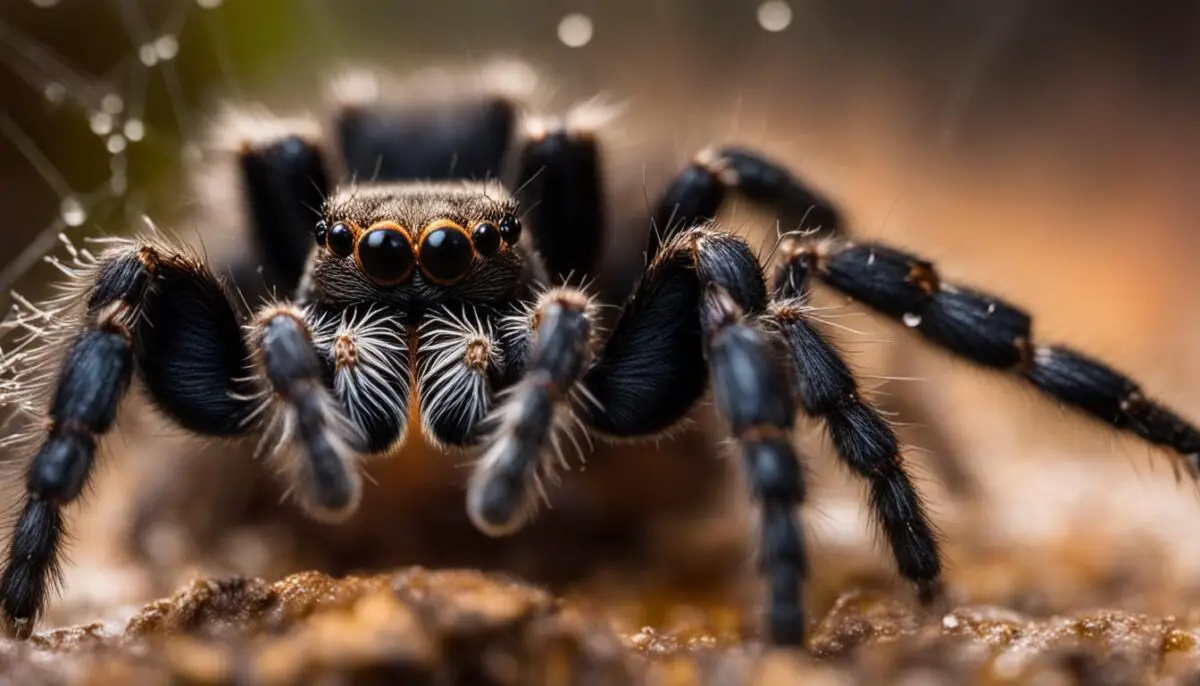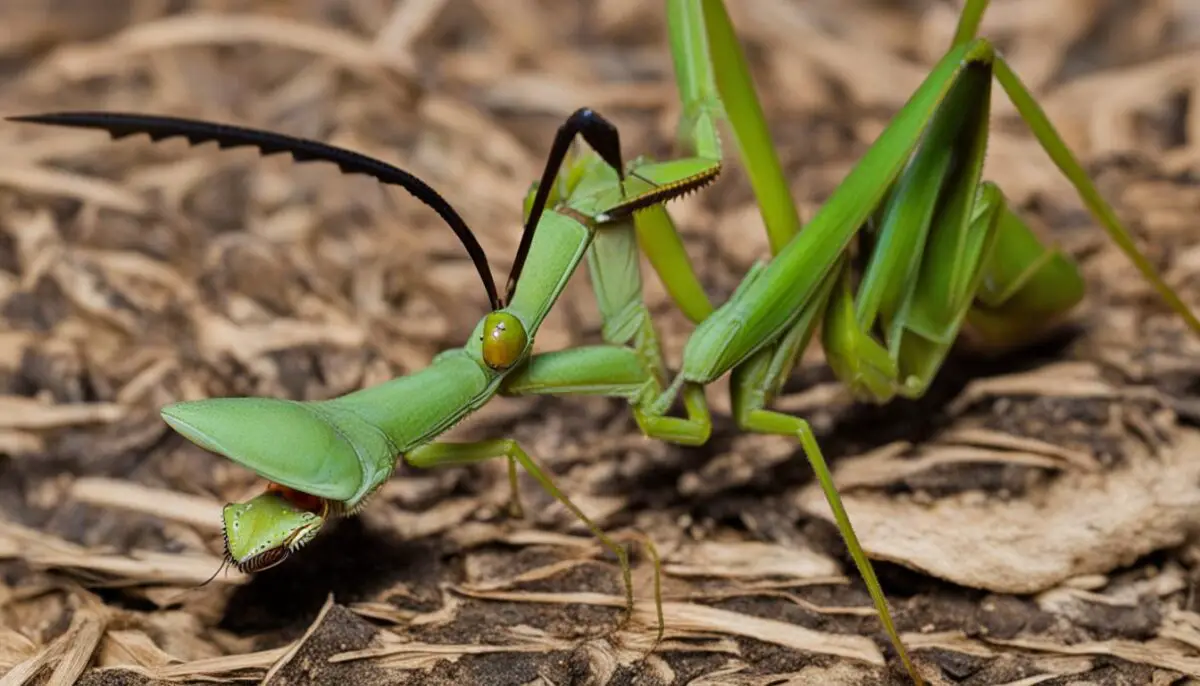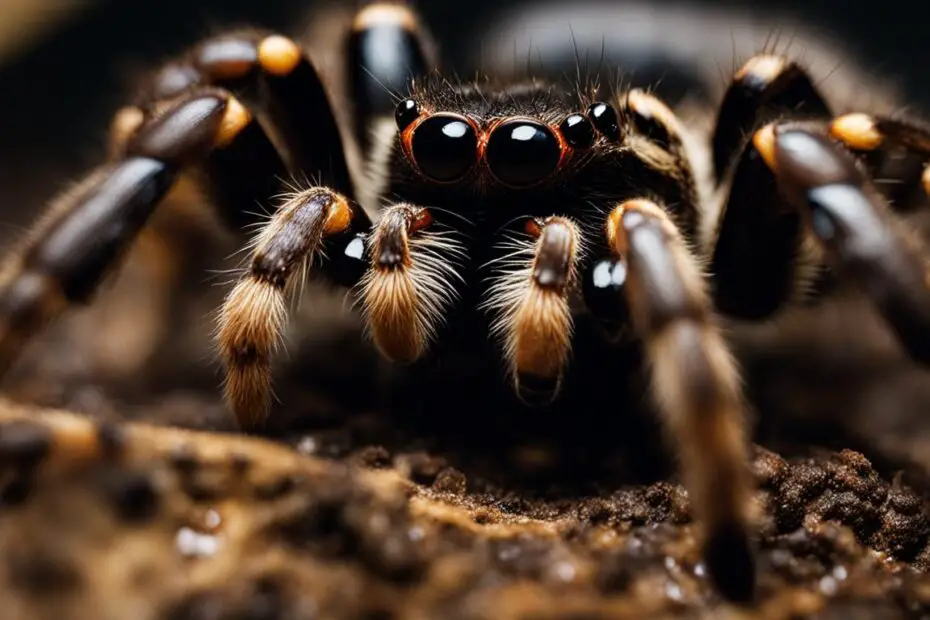Have you ever wondered why tarantulas eat? These fascinating creatures have unique feeding habits and a diverse diet that may surprise you. Join us as we delve into the world of tarantula feeding and explore their dietary preferences and hunting techniques.
Key Takeaways:
- Tarantulas are carnivores and feed on a variety of prey.
- Their diet includes large insects, frogs, toads, fish, lizards, bats, and even small rodents and snakes.
- Tarantulas use their sharp fangs to inject venom and digestive enzymes into their prey, liquefying the body for ingestion.
- They have a unique feeding behavior and digestive process, utilizing a “sucking stomach” to drain and digest the liquefied prey.
- Tarantulas hunt close to their habitats and employ silk in their hunting techniques.
Why Tarantulas Eat
Tarantula Feeding Behavior and Digestive Process
Tarantulas have a unique feeding behavior and digestive process that sets them apart from other creatures. They utilize their fangs to inject venom and digestive fluids into their prey, effectively paralyzing and liquefying the body. This remarkable adaptation allows tarantulas to consume their prey in a liquid form, as they lack the ability to eat solid foods. The venom and digestive enzymes injected by tarantulas serve to break down the prey’s internal tissues, turning them into a nutritious liquid that can be ingested.
Once the prey is liquefied, tarantulas employ a “sucking stomach” mechanism to draw the liquefied prey into their mouths and further ingest it into their intestines. Within the intestines, the food is broken down into smaller particles that can be absorbed through the intestinal walls and distributed throughout the tarantula’s body, providing the necessary nutrients for its survival. After the feeding process is complete, tarantulas often form the remaining carcass into a small ball and dispose of it.
“Tarantulas have a unique feeding behavior, injecting venom and digestive fluids into their prey to liquefy the body.”
This feeding behavior showcases the incredible adaptations of tarantulas to their carnivorous lifestyle. It is a fascinating example of how nature has shaped these creatures to thrive in their environment, ensuring their survival and successful reproduction.
| Aspect | Description |
|---|---|
| Feeding Behavior | Tarantulas inject venom and digestive fluids into their prey to liquefy the body. |
| Digestive Process | The liquefied prey is drawn into the tarantula’s mouth and further ingested into its intestines. |
| Breaking Down Food | The food is broken down into small particles that can be absorbed through the intestinal walls. |
| Nutrient Distribution | The absorbed nutrients are spread throughout the tarantula’s body, providing essential sustenance. |
| Disposal of Carcass | After feeding, tarantulas often form the prey’s carcass into a small ball and dispose of it. |
This detailed process of tarantula feeding and digestion highlights the complexity and efficiency of their remarkable digestive system. It is a testament to the unique adaptations developed by these fascinating creatures over millions of years of evolution.
Tarantula Food Preferences and Hunting Techniques
Tarantulas are fascinating creatures with diverse food preferences and unique hunting techniques. Let’s explore their dietary habits and how they secure their meals in the wild. tarantula feeding habits
Food Preferences:
- Tarantulas are opportunistic feeders and generalist hunters. They have a wide range of food preferences, enabling them to survive in different habitats.
- Their primary food sources include large insects like crickets, grasshoppers, June beetles, and caterpillars.
- Some tarantula species are known to consume amphibians, reptiles (such as lizards), bats, fish, and even small mammals like rodents and snakes.
These adaptable hunters select their prey based on availability and the specific needs of their species.
Hunting Techniques:
Tarantulas employ various hunting techniques to catch their prey effectively:
- Web-based Hunting: Tree-dwelling tarantula species use silk to create “tube tents” or webs where they wait for prey to come within reach. Once a suitable target is detected, they swiftly immobilize it with venomous bites.
- Ambush Hunting: Ground-dwelling tarantulas rely on camouflage to blend into their surroundings. They lie in wait until unsuspecting prey ventures close enough to be captured. These tarantulas then strike with lightning speed, injecting paralyzing venom to subdue their unsuspecting meal.
- Pursuit Hunting: Some agile tarantulas actively chase down prey items. With their exceptional speed and agility, they are able to capture swiftly moving prey, making them highly effective predators.
These hunting techniques, combined with the tarantula’s venomous bite, ensure a successful catch and a satisfying meal.
| Food Preferences | Hunting Techniques |
|---|---|
| Tarantulas have a wide range of food preferences including large insects, amphibians, reptiles, bats, fish, small mammals, and even other spiders. | Tarantulas employ various hunting techniques such as web-based hunting, ambush hunting, and pursuit hunting to secure their prey. |
| Tarantulas select their prey based on availability and the specific needs of their species. | These hunting techniques, combined with the tarantula’s venomous bite, ensure a successful catch and a satisfying meal. |
Understanding tarantula food preferences and hunting techniques gives us insight into their role as skilled predators in their respective ecosystems. These fascinating arachnids have developed unique strategies to ensure their survival and nourishment. tarantula diet

Tarantula Nutritional Needs and Dietary Requirements
Tarantulas have specific nutritional needs and dietary requirements to thrive and maintain optimal health. As carnivorous creatures, their diet consists mainly of protein and lipids, which they obtain from their prey. It is crucial to provide tarantulas with a diverse and balanced diet to ensure they receive all the necessary nutrients. reasons tarantulas eat
When it comes to feeding pet tarantulas, suitable food sources include crickets, grasshoppers, mealworms, king worms, silkworms, dubia roaches, and hornworms. These live insects should be gut-loaded, meaning they are fed nutritious food before being offered to the tarantulas. This ensures that the prey item itself is rich in the essential nutrients tarantulas require. what tarantulas eat
To meet their dietary needs, tarantulas should be fed a few times a week, with the appropriate portion size. It is important to avoid overfeeding as this can lead to obesity and other health issues. Additionally, any uneaten food should be promptly removed from the enclosure after about 10 minutes to prevent injury from hungry prey insects.
| Food Source | Nutritional Benefits |
|---|---|
| Crickets | High in protein and vitamins |
| Grasshoppers | Rich in protein and minerals |
| Mealworms | Good source of protein and fats |
| King worms | High in protein and calcium |
| Silkworms | Rich in protein and essential amino acids |
| Dubia roaches | High in protein and low in fat |
| Hornworms | Excellent source of hydration and protein |
In addition to a suitable diet, tarantulas also require access to fresh water. A shallow dish of water should be provided in the enclosure, ensuring it is not deep to prevent drowning. Tarantulas will drink from the water source as needed to stay hydrated. tarantula feeding behavior
Understanding the nutritional needs and dietary requirements of tarantulas is essential for their overall well-being. By providing a varied and appropriate diet, tarantula owners can ensure the health and longevity of their fascinating pets.
Tarantula Predators: Who Preys on Tarantulas?
Tarantulas, despite being fearsome predators themselves, have natural enemies in the animal kingdom. Some of the primary predators of tarantulas are tarantula hawks, a type of wasp. These specialized predators actively track and attack large tarantulas, paralyzing them with a sting and laying an egg on their back. The hatched larva then burrows into the tarantula’s body, feeding on its insides. This unique relationship between tarantulas and tarantula hawks showcases the fierce battles that take place in the wild. nutritional needs of tarantulas
Another formidable predator of tarantulas is the giant centipede. These aggressive and venomous creatures are known to prey on tarantulas, overpowering them with their speed and strength. Giant centipedes have a wide range of prey, and their robust pincers and venomous bite make them a major threat to tarantulas.
While tarantulas typically face predation from other animals, they are also vulnerable to human activity. In some cultures, tarantulas are considered a delicacy and are enjoyed as food after roasting them to remove the irritating hairs. Although humans are not natural predators of tarantulas, their hunting practices and destruction of tarantula habitats can significantly impact the population of these fascinating arachnids.
| Predator | Description |
|---|---|
| Tarantula Hawks | A type of wasp that paralyzes tarantulas and lays eggs on their backs. The larva hatches and feeds on the tarantula’s body. |
| Giant Centipedes | Aggressive and venomous centipedes that overpower tarantulas with their speed and strength. |
| Humans | In certain cultures, tarantulas are considered a delicacy and can be consumed after proper preparation. |
Quote:
In the wild, tarantulas face a range of predators, from specialized wasps to formidable centipedes. These natural enemies highlight the dynamic and sometimes dangerous interactions found in the animal kingdom.

It is important to understand the threats that tarantulas face in their natural habitats and strive to protect their populations. Conservation efforts and responsible practices can help maintain the delicate balance of ecosystems where tarantulas play a vital role. By appreciating the intricate web of predator-prey relationships, we can foster a deeper appreciation for the complexity of nature. tarantula hunting and eating
Tarantula Lifespan and Care as Pets
Tarantulas can make fascinating and low-maintenance pets, but it’s important to understand their lifespan and care requirements to ensure their well-being. On average, male tarantulas can live up to 10 years, while females have a much longer lifespan, often surpassing 30 years. These impressive creatures require specific housing, feeding, and veterinary care to thrive in captivity.
Tarantula Housing and Enclosure
When housing a pet tarantula, it’s essential to provide a suitable enclosure that mimics their natural habitat. A 20-gallon aquarium or larger is recommended to accommodate their size and allow them space to move and explore. The enclosure should be located in a quiet area of the home, away from excessive noise and bright lights, as these can stress the tarantula. A tight-fitting screen top is necessary to prevent escape, and it’s crucial to arrange rocks and other objects within the enclosure to prevent injury. tarantula digestive system
| Requirement | Description |
|---|---|
| Enclosure Size | A 20-gallon aquarium or larger is recommended. |
| Noise and Light | Keep the enclosure in a quiet area away from excessive noise and bright lights. |
| Security | Use a tight-fitting screen top to prevent escape. |
| Environmental Enrichment | Arrange rocks and objects to provide a stimulating environment and prevent injury. |
Tarantula Feeding and Nutrition
Feeding pet tarantulas requires providing them with a suitable diet of live food sources. Crickets, mealworms, king worms, and other gut-loaded insects are excellent choices. It’s essential to avoid overfeeding and promptly remove any uneaten food to prevent injuries from hungry prey insects. Tarantulas also require access to fresh water in a shallow dish to stay hydrated. It’s crucial to research and follow specific feeding guidelines for the species of tarantula you have as their dietary requirements may slightly vary.
“Feeding pet tarantulas requires providing them with a suitable diet of live food sources.”
Veterinary Care for Tarantulas
While tarantulas are generally hardy creatures, they may require veterinary care in certain situations. Common reasons to seek veterinary assistance include issues with the molting process and oral nematodes, which are a common infectious issue in tarantulas. If you notice decreased appetite, white material around the mouth, or concerns with molting, it’s essential to consult an exotics veterinarian experienced with tarantulas for proper diagnosis and treatment.
By providing appropriate housing, feeding, and veterinary care, you can ensure the well-being and longevity of your pet tarantula. Remember to always research and follow species-specific care guidelines to meet their unique needs.
Tarantula Housing and Enclosure Requirements for Pet Tarantulas
Proper housing and enclosure requirements are crucial for providing a suitable environment for your pet tarantula. Creating a comfortable and secure space will ensure their well-being and help them thrive. Here are some important factors to consider when setting up a tarantula habitat:
Habitat Size:
It is recommended to house your tarantula in a 20-gallon aquarium or larger. This will provide enough space for the tarantula to move around and establish their territory. A spacious enclosure also allows for the addition of hiding areas and climbing structures, which are essential for the tarantula’s mental and physical stimulation.
Substrate:
Choose a soft and absorbent substrate for the enclosure. Some suitable options include coconut fiber, peat moss, or a mixture of both. The substrate should be at least a few inches deep to allow for burrowing, as this is a natural behavior for many tarantula species. Avoid using materials like sand or wood chips, as they can be irritating to the tarantula’s sensitive exoskeleton.
Temperature and Humidity:
Maintain a temperature range of 70°F to 85°F (21°C to 29°C) in the tarantula’s habitat. Use a reptile heat mat or a ceramic heat emitter to provide a stable heat source. It is also important to monitor and regulate the humidity levels in the enclosure. Many species of tarantulas require higher humidity, usually between 60% and 80%. Spraying the enclosure with water or using a humidifier can help achieve the desired humidity levels.

Tarantula Feeding Guidelines
Feeding pet tarantulas requires careful consideration to ensure their nutritional needs are met. Follow these feeding guidelines to keep your tarantula healthy and thriving:
- Provide live food sources: Tarantulas are carnivores and require a diet rich in protein. Offer gut-loaded insects such as crickets, mealworms, king worms, silkworms, dubia roaches, and hornworms as suitable food sources.
- Avoid overfeeding: It is crucial not to drop multiple prey items into the enclosure at once. This can lead to injuries caused by hungry prey insects. Instead, offer a sufficient amount of food that can be consumed within approximately 10 minutes.
- Remove uneaten food promptly: If your tarantula does not consume all the offered food within the given timeframe, remove any uneaten prey items from the enclosure. Leaving uneaten food can attract pests and pose a risk to your tarantula’s health.
- Provide fresh water: Make sure your tarantula has access to a shallow dish of fresh water in its enclosure. Ensure that the water is not too deep to prevent drowning.
By following these feeding guidelines, you can provide your pet tarantula with a balanced and appropriate diet. Monitoring their feeding habits and adjusting the quantity of food as needed will help maintain their health and well-being.

Table: Recommended Foods for Pet Tarantulas
| Food | Description |
|---|---|
| Crickets | Provide a good source of protein and are commonly available. |
| Mealworms | Rich in protein and often readily accepted by tarantulas. |
| King worms | Another protein-rich option that tarantulas enjoy. |
| Silkworms | Provide a diet variation and are suitable for larger tarantulas. |
| Dubia roaches | High in protein and a popular choice for tarantulas. |
| Hornworms | Offer a nutritious snack and can be fed to larger tarantulas. |
Remember to always consult with an exotics veterinarian for further advice on tarantula care and to address any specific concerns regarding your pet’s feeding needs.
Tarantula Veterinary Care: When to Seek Professional Help
While tarantulas are generally hardy creatures, there may be instances where veterinary care is necessary for their health and well-being. Knowing when to seek professional help can make a significant difference in ensuring the optimal care of your pet tarantula.
One common issue that may require veterinary attention is the presence of oral nematodes. These are infectious parasites that can affect the mouth of tarantulas, leading to a decreased appetite and the appearance of white material around the mouth. If you observe these symptoms, it is important to consult a veterinarian who specializes in exotics to diagnose and treat the condition.
Another situation where veterinary care may be needed is during the molting process. Tarantulas undergo molting to shed their old exoskeleton and grow. It is crucial to understand that tarantulas typically fast and refuse food prior to molting. However, rushing the tarantula to the veterinarian during this time can be detrimental, as they should not be moved or disturbed. If you have concerns about your tarantula’s molting process, it is best to consult a veterinarian experienced in tarantula care for guidance and advice.
| Signs of Oral Nematodes | Concerns During Molting |
|---|---|
|
|
“Knowing when to seek professional veterinary care is crucial for ensuring the well-being of your pet tarantula.”
When it comes to tarantula veterinary care, it is important to find a veterinarian who has experience and knowledge in treating exotic pets, specifically tarantulas. Reach out to local exotic veterinary clinics or specialty veterinarians who can provide the necessary care and guidance for your tarantula’s specific needs.
By understanding the potential veterinary issues that can arise with tarantulas and knowing when to seek professional help, you can ensure the health and happiness of your pet tarantula. Always remember to observe your tarantula’s behavior and seek assistance if you notice any concerning signs or changes in their well-being.
Tarantulas and Fruit: Can They Eat It?
While tarantulas are primarily carnivorous, there have been reports of them consuming bits of fruit. However, it is important to note that tarantulas do not have the necessary digestive enzymes to efficiently process fruits. While some tarantulas may eat small amounts of fruit without immediate digestive issues, it is best to stick to their regular carnivorous diet to ensure their overall health and well-being. Their digestive process involves injecting venom and digestive fluids into their prey, and the interaction between these enzymes and the compounds found in fruits is still not fully understood.

“Tarantulas are primarily carnivorous and do not have the necessary digestive enzymes to efficiently process fruits.”
It is worth mentioning that tarantulas have complex dietary requirements, needing a diet rich in protein and lipids which they obtain from their prey. Insects such as crickets, grasshoppers, mealworms, king worms, silkworms, dubia roaches, and hornworms are recommended as suitable food sources. Some tarantulas even consume young vertebrate prey, such as pinky mice. It is essential to provide live food sources to tarantulas to meet their nutritional needs. Feeding them a few times a week and promptly removing any uneaten food are crucial practices to prevent injuries from hungry prey insects.
In conclusion, while tarantulas have been reported to eat bits of fruit, it is advisable to maintain their carnivorous diet to ensure their optimal health. By understanding the unique eating habits and dietary requirements of tarantulas, we can provide them with the proper care they need and appreciate these fascinating creatures as pets.
Conclusion
In conclusion, tarantulas are carnivores that have a diverse diet, including large insects, amphibians, reptiles, and even small mammals. Their feeding behavior involves injecting venom and digestive fluids into their prey, which liquefies the body for easy ingestion. To meet their specific nutritional needs, tarantulas require a diet that is rich in protein and lipids.
As pets, tarantulas need proper housing and care. It is important to provide suitable enclosures that offer enough space for them to move around, along with hiding areas. Temperature regulation is crucial, with a recommended range of 70°F to 85°F. Live food sources, such as gut-loaded insects, should be provided to fulfill their carnivorous diet.
Regular veterinary care may be necessary for certain issues that tarantulas may face. It is important to consult with a local exotics veterinarian for advice on tarantula care and to address any concerns that may arise. Additionally, it is worth noting that while there have been reports of tarantulas eating bits of fruit, it is recommended to stick to their carnivorous diet for their optimal health.
By understanding the unique eating habits and dietary needs of tarantulas, we can ensure their well-being and enjoy these fascinating creatures as companions. Providing them with the right food, suitable housing, and necessary care will help to create a harmonious environment for tarantulas and their owners alike.
FAQ
What do tarantulas eat?
Tarantulas are carnivores and feed on a variety of prey, including large insects like crickets, grasshoppers, beetles, and caterpillars. Some species may also eat frogs, toads, fish, lizards, bats, and small rodents and snakes.
How do tarantulas eat their prey?
Tarantulas use their fangs to inject venom and digestive fluids into their prey, which paralyzes and liquefies the body. They then use straw-like mouthparts to suck up the liquefied prey. Tarantulas have a “sucking stomach” that allows them to drain the prey through their mouth and into their intestines.
What role does silk play in tarantula hunting?
Silk plays a crucial role in tarantula hunting techniques. Tree-dwelling species use silk to create silken “tube tents” where they can watch for prey and eat their meals. Terrestrial species line their burrows with silk, which stabilizes the walls and allows them to climb up and down when hunting or mating.
What are suitable food sources for pet tarantulas?
Suitable food sources for pet tarantulas include live insects like crickets, mealworms, king worms, silkworms, dubia roaches, and hornworms. Some tarantulas can also eat young vertebrate prey, such as pinky mice.
What predators do tarantulas have?
Tarantulas have predators such as tarantula hawks, giant centipedes, and humans. Tarantula hawks are specialized wasps that paralyze and lay an egg on tarantulas, allowing the larva to feed on them. Humans in certain cultures may also consider tarantulas as a delicacy.
How long do tarantulas live as pets?
Tarantulas can live for a long time as pets, with males living up to 10 years and females living beyond 30 years.
What are the housing and enclosure requirements for pet tarantulas?
Pet tarantulas should be housed in a 20-gallon aquarium or larger, in a quiet and dimly lit area of the home. The enclosure should provide enough space for the tarantula to move and walk around, with at least one hiding area. The substrate should be soft and absorbent, and a few rocks can be added for climbing opportunities.
How often should pet tarantulas be fed?
Pet tarantulas should be fed a few times a week, with live food sources like crickets, mealworms, and other suitable insects. Uneaten food should be promptly removed to prevent injuries from hungry prey insects.
When should veterinary care be sought for pet tarantulas?
Veterinary care for pet tarantulas may be necessary in cases of oral nematodes or issues with the molting process. Consult with a local exotics veterinarian for advice on tarantula care and to address any concerns.
Can tarantulas eat fruit?
While some tarantulas have been reported to eat bits of fruit, it is not recommended to include fruit in their diet. Tarantulas are carnivores and do not have the necessary digestive enzymes to process fruits efficiently.

